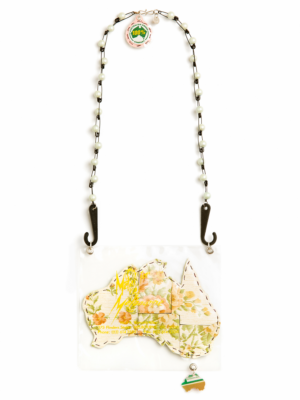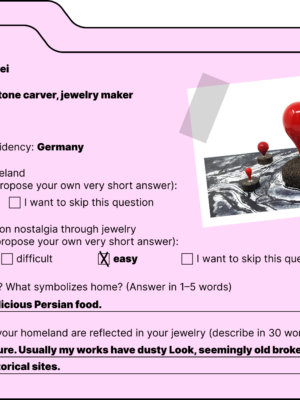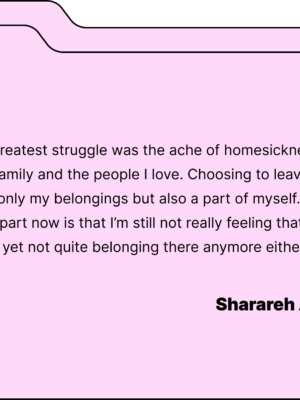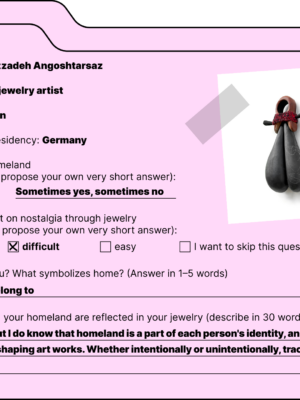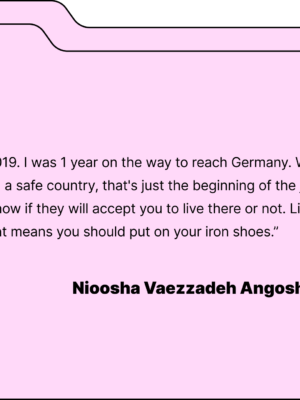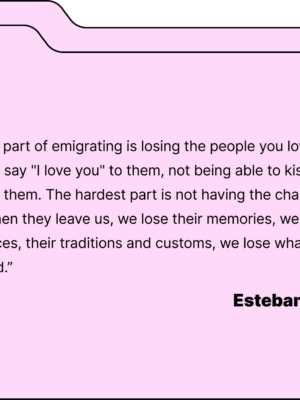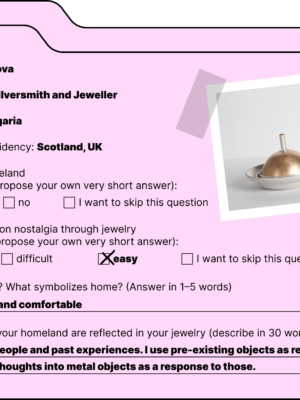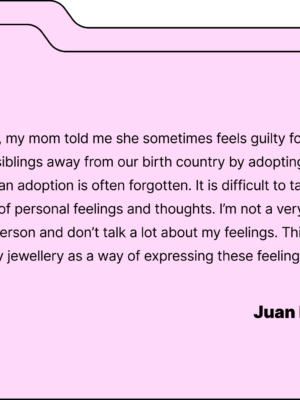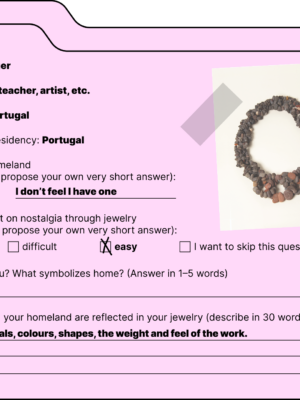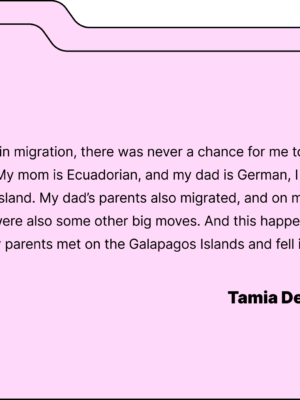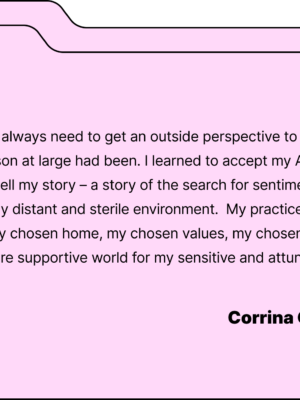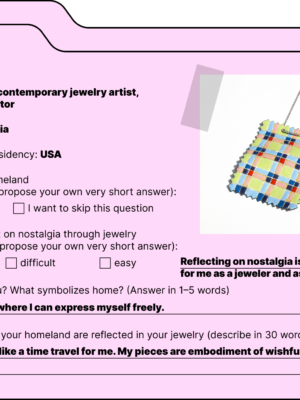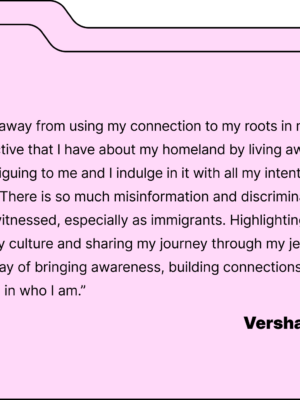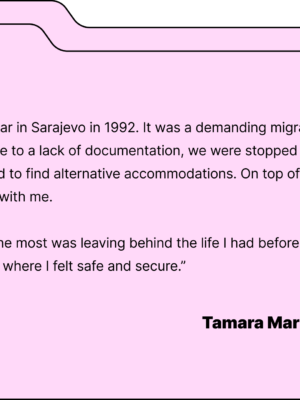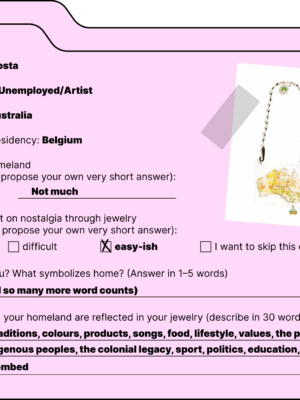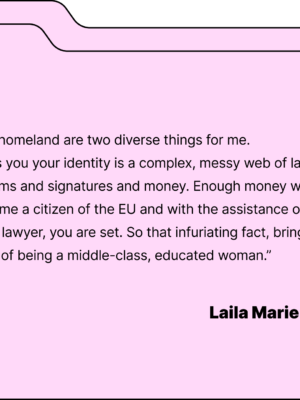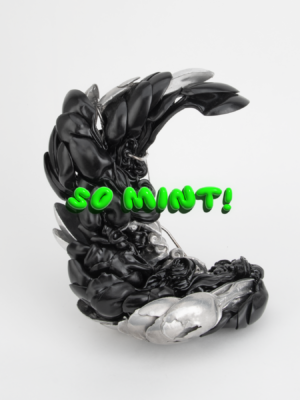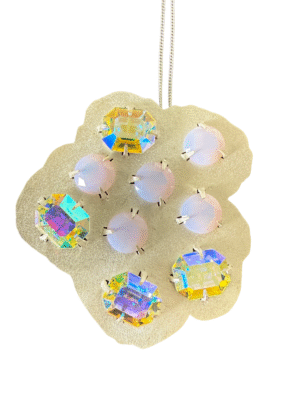I chose to send them a uniform, rather formal questionnaire to create a catalogue reminiscent of the endless folders and archives of bureaucratic institutions—places that often become sanctuaries, pilgrimage sites for migrants. What better symbol of such places than a questionnaire? Hundreds of filled-in fields, monosyllabic questions, limited response options.
I provided the jewellers with a small space and included open-ended questions. I aimed to achieve an effect similar to that of infographics: presenting ‘dry’ facts that allow the viewer or reader to draw their own conclusions.
Each card in this compact ‘filing system’ features a brief excerpt from a jeweller’s reflections on the search for home, migration stories, or the meaning behind their work related to these themes. On the reverse side is a questionnaire tied to feelings and memories associated with home.
You can read the full text of this piece, or simply browse through the cards created for each author’s ‘case.’ They succinctly capture the thoughts and emotions of jewellers connected to migration.
___STEADY_PAYWALL___
HOME
Have you ever considered how fragile your sense of home is and what it truly means to you? For Gaston Bachelard, the renowned philosopher, home is a place ‘which allows one to dream in peace.’¹ For Chantal Akerman, the Belgian filmmaker, home was her mother; with her passing, the very concept of home ceased to exist for her.
Home could be just a physical space, yet the architecture and spatiality of home are far more complex than they might seem. Dutch architect and theorist Reinier de Graaf recalls someone asking him shortly after graduation, ‘Why did you study so intensively for so long? Isn’t architecture basically just four walls and a roof?’²
I’m convinced that, to paraphrase William Blake’s words ‘To see a world in a grain of sand,’³ we can see a home(land) in a piece of jewellery. Often, jewellers aren’t even aware that nuances in their work convey nostalgia and hint at their homeland. This topic is very personal, so we often don’t know what really lies behind the beautiful pieces we see in carefully arranged exhibitions behind glass vitrines.
Through several conversations, I realised that many in the jewellery community are migrants who left their countries for various reasons, temporarily or permanently. I, too, have been a migrant since 2022. I had to move from Belarus to Portugal. My projects, l’Étrangère⁴ and Lost in Migration, delve into the meaning of ‘home.’ This theme resonates with me, partly due to my background in architectural education.
I’m not an architect, but since 2016 I’ve been leading a project called the Architectural Thinking School for Children. Interestingly, we don’t teach youth to become architects—we teach them to think like architects. That means understanding current issues and proposing solutions. Thus, just as architecture today is more than the construction of buildings, home is more than a physical space, migration—more than a movement from point A to point B. As one jeweller, Sharareh Aghaei, aptly put it, migration ‘means packing not only belongings but also a part of myself.’
10 Stories to be Told and Heard
Sharareh maintains a connection to her homeland, Iran, through the techniques she employs. Her pieces are woven on a loom—a national craft in Iran—but she replaces thread with wires, creating delicate metal nets covered with layers of cement, stone fragments, and powder, resembling ancient artifacts. Even when she avoids repeating familiar patterns and motifs, her homeland, with its vibrant and rich palette, is revealed through the colour choices in her pieces: often turquoise and the deep blue of lapis lazuli.
Also from Iran, Nioosha’s work exudes authenticity and often conveys pain over the strict traditions of her homeland, critiquing the suppression of women’s rights. Missing home is complicated when returning isn’t an option. For Nioosha, migration was a necessity for survival. She crossed borders to reach Germany without a passport, uncertain of the intentions of those new people she met on her way. ‘But you have to trust; sometimes you don’t have any other chance,’ she concludes.
For Esteban, home is primarily about connections—people and family. His works feature fading, sometimes faceless portraits, eroded by time, movement, and memory. Right on the day we discussed migration, he incorporated stones into his pieces that his father had kept for over 70 years and, at 94, cut in Mexico before mailing them to him. ‘They’re not perfect, and maybe not even beautiful, but they’re memory and remembrance.’
Militsa shares a similar feeling of seizing the fading strands of connections to people and family but preserves it through small objects that traveled with her and her relatives. Objects which are witnesses of memories, events. Born in Bulgaria, she moved to Greece as a child and later to Scotland. Her reflection on home began in 2022 with a brooch about Piraeus, Greece. Since then, her work increasingly explores connections with family members, even those long gone, by examining photographs and objects that belonged to them.
Isn’t it another form of forced migration–adoption? Juan, born in Colombia, was adopted and literally saved by a Belgian family at one year old. In his Mend series, like Militsa, he uses real items as memory symbols—specifically clothing, scraps of handkerchiefs. His delicate pieces reflect his childhood, helping his mother mend clothes. It’s about the beauty in repair and a tribute to his mother, who still feels guilt over removing him from his native land. This aspect of adoption is often overlooked.
Born on the warm, exotic island of Madeira, Tamia now lives in Lisbon (but the story behind her family’s journey is far more intricate!). Much of her work incorporates materials from the island—beach pebbles, stone textures, and tactile references to sun-warmed coastal landscapes. Even when viewers don’t recognise the specific source, they often connect emotionally to the materiality, evoking memories of similar beaches, sea, and warmth.
Can love for jewellery prompt migration? Absolutely. Corrina emigrated from the USA to Germany* twelve years ago, believing Munich Jewellery Week was the best contemporary jewellery event globally and that a supportive community awaited her. Interestingly, her work doesn’t dwell on longing or nostalgia but satirises the capitalist nature of her homeland. She often uses parts of contemporary technological devices, items that quickly become obsolete, turning into relics—fossils of fast-paced American culture.
*While this piece was being prepared, Corrina was studying for the German nationality test, the results of which won’t be known until the end of summer. The feeling of suspense is something that never quite leaves an emigrant.
What might a jeweller say who, on the contrary, moved to the USA? Vershali moved there from India in 2016 with her husband. Their situation seemed manageable: her husband had official employment, and they began the legalisation process. However, neither has obtained documents allowing full participation in society or international travel. According to a 2024 Forbes report, over a million Indians await employment-based immigration approvals, with backlogs projected to take up to 195 years to clear. Vershali is currently working on a series inspired by the Japanese term Natsukashii, referring to the bittersweet nostalgia felt when encountering familiar objects. Her vibrant pieces, reminiscent of India, have become her survival story.
Tamara’s pieces are monumental, paradoxically so for jewellery. They reference brutalist structures from her homeland, Yugoslavia, from which she fled in 1992. She admits that conveying personal emotions tied to memories and places through wearable objects is challenging, especially when the audience doesn’t share similar experiences.
‘Borders and visas and borders and visas and borders,’ is how Laila describes her migration journey. With Italian roots, she grew up in Australia and moved to Belgium to rediscover herself as an artist. Despite her European ancestry, she can’t obtain EU citizenship. Laila explores her identity, situated between two continents, not only through jewellery but also in her performative practice developed during her move to Belgium and studies at MASieraad. She has created two alter egos to discuss integration and identity, naturally adorned with costumes, attributes, and jewellery. Found objects, pill blisters, and cultural symbols like Vegemite sauce are integral to her works and performances.
Is There any Conclusion?
As of 2025, what practical freedoms do individuals have regarding movement? The Universal Declaration of Human Rights (1948)⁵ states that everyone has the right to:
• Move freely within a country
• Return to one’s country
• Leave any country
• Seek asylum in other countries
These rights remain unchanged, yet in practice, governments may interpret or restrict them. Unfortunately—or perhaps fortunately—due to these limitations, the stories described above emerge. And from these stories their works materialise.
¹ Gaston Bachelard, The Poetics of Space, trans. Maria Jolas (Boston: Beacon Press, 1994).
² Reinier de Graaf, Four Walls and a Roof: The Complex Nature of a Simple Profession (Cambridge, MA: Harvard University Press, 2017), p. 15.
³ William Blake, Auguries of Innocence, in The Complete Poetry and Prose of William Blake, ed. David V. Erdman, rev. edn (Berkeley: University of California Press, 2008), p. 490.
⁴ More information about the project here: https://elenakarpilova.com/letrangere
⁵ United Nations, Universal Declaration of Human Rights, https://www.un.org/en/about-us/universal-declaration-of-human-rights#:~:text=Article%2013,to%20return%20to%20his%20country [accessed 30 May 2025].
Cover image:
Laila Marie Costa
‘Shtralia’
Visuals designed by Tanya Smantser.
This year’s theme for our digital publishing is Language. Through a selection of articles we dive into visual languages, the communication of objects, iconography and symbolism. Focusing on story-telling through a lens of aesthetics, we are eager to bring assorted trains of thought to you by twelve different authors. The articles range from speculative to theoretical, chaste to raunchy, past to future, bringing you a variety of voices and perspectives.
This year’s digital publishing features isabel wang pontoppidan as guest editor. isabel is a Danish-Chinese writer, artistic researcher and jewellery maker based in Amsterdam. Her practice is multi-pronged, combining writing, performance, research and jewellery in a variety of overlapping cross-sections.
